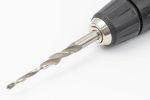Files: Shaping Materials with Precision
Files are hand tools with a textured surface used to shape, smooth, and refine wood and other materials by removing small amounts of material through abrasion.
Files consist of a metal shaft with a series of parallel, raised ridges or teeth along its length.
These teeth are designed to cut and remove material when the file is drawn across a workpiece. Files come in various shapes and sizes, each suited to specific tasks in woodworking.
Types of Files
Common types of files used in woodworking include:
- Flat File: A flat file has a rectangular cross-section and is used for general-purpose filing, flattening surfaces, and smoothing straight edges.
- Half-Round File: Half-round files have a flat side and a curved side, making them suitable for shaping convex and concave surfaces.
- Round File: Round files are cylindrical in shape and are used for enlarging holes, shaping curved grooves, and rounding edges.
- Rasp File: Rasps have larger and coarser teeth compared to regular files, making them suitable for quickly removing material and shaping irregular surfaces. They are often used in rough shaping tasks.
- Needle File: Needle files are small files with fine teeth, ideal for intricate work, detail shaping, and working on small or delicate parts.
- Cabinet File: Cabinet files are typically slim and rectangular, designed for fine finishing and detail work, such as fitting joints or working in tight spaces.
- Triangle File: Triangle files have a triangular cross-section and are useful for shaping corners and angles.
- Wood Rasp: Wood rasps are similar to rasps but have finer teeth designed specifically for woodworking. They are excellent for shaping wood quickly and efficiently.
When using files in woodworking, it’s important to use the appropriate type and grade of file for the specific task at hand.
Files are versatile tools that allow woodworkers to refine their work by removing small amounts of material at a time, ensuring precision and a smooth finish.
Anatomy of a File
The anatomy of a file used in woodworking is similar to that of a general hand file, but there are some specific features and considerations for woodworking files.
Here’s the anatomy of a file for woodworking:
- Tang: The tang is the pointed or tapered end of the file, typically inserted into a handle or grip. It allows the user to hold and control the file while working. The tang may vary in shape, such as square, rectangular, or rounded, depending on the file type.
- Heel: The heel is the wider and thicker portion of the file, located near the tang. It provides stability and strength to the file, and it’s the end that you grasp or attach to a handle.
- Point: The point is the end opposite the tang. In woodworking files, the point is usually blunt or slightly rounded to prevent it from digging into the material unintentionally.
- Face: The face of the woodworking file is the flat or slightly curved surface along the length of the file where the teeth or cutting edges are located. The face makes contact with the wood when filing or shaping.
- Teeth or Cutting Surface: This is the most critical part of the file for woodworking. Woodworking files have rows of small, sharp teeth or cutting edges along their faces. The size and pattern of these teeth can vary widely depending on the type of file and its intended purpose. Common patterns include single-cut, double-cut, rasp-cut, and more.
- Safe Edge: Some woodworking files have a safe edge, which is one edge of the file that is smooth and free of teeth. This allows you to work close to an edge or corner without damaging adjacent surfaces.
- Edges: The edges of the file are the narrow sides perpendicular to the face. They are not typically used for cutting but may be useful for certain tasks or in confined spaces.
- Back or Spine: The back or spine of the file is the top surface opposite the cutting surface. It provides rigidity and support to the file and helps maintain the file’s shape.
- Length: The length of the file varies depending on the type and purpose of the file. Longer files are used for larger tasks, while shorter files are more suitable for precision work.
- Cross Section: The cross-sectional shape of the file can vary. Common shapes include flat, round, half-round, and triangular, each suited to specific woodworking tasks.
Understanding the anatomy of a woodworking file is essential for selecting the right file for a particular woodworking task and for using it effectively to shape, smooth, and refine wood surfaces.
File Applications in Woodworking
Files are versatile hand tools used in woodworking for various applications that involve shaping, smoothing, and refining wood surfaces.
The choice of file type depends on the specific task at hand. Here are some common file applications in woodworking:
- Shaping Edges: Files are used to shape the edges of wooden boards or components. This is often done to create beveled edges, decorative profiles, or rounded corners.
- Smoothing Surfaces: Files can be used to smooth rough or uneven surfaces, removing imperfections and preparing the wood for finishing. They are particularly handy for leveling small irregularities.
- Joint Fitting: Woodworkers use files to refine the fit of joints like dovetails, mortise and tenon joints, and lap joints. This ensures a snug and precise fit for strong and aesthetically pleasing connections.
- Trimming Dowels: When wooden dowels are used for joinery, files are used to trim and fit them precisely into holes or mortises.
- Notching and Grooving: Files are employed to create notches and grooves in wood for various purposes, such as accommodating hardware, creating channels for wiring, or adding decorative elements.
- Removing Excess Glue: After assembling wood components with glue, files can be used to carefully remove any excess adhesive that may have squeezed out from joints.
- Cleaning Up Miters: When making mitered cuts for frames or corners, files help clean up and refine the cut edges, ensuring tight and accurate joins.
- Fretwork and Scrollwork: For intricate scrollwork and fretwork patterns in woodworking projects, needle files and small detail files are used to shape and smooth delicate curves and details.
- Shaping Small Parts: Files are especially useful for shaping small wooden parts or components that are difficult to work on with larger woodworking tools.
- Final Touches: Before applying finishes like paint or varnish, files are used to remove any final imperfections, ensuring a smooth and flawless surface.
- Custom Profiles: Woodworkers often use files to create custom profiles and moldings, tailoring the design to their specific project requirements.
- Refinishing and Restoration: When restoring antique furniture or refinishing wooden surfaces, files are used to remove old finishes, blemishes, and imperfections in the wood.
It’s important to choose the right type and grade of file for the task to achieve the desired results.
Additionally, proper file maintenance, including regular cleaning and occasional reconditioning, helps prolong their effectiveness and lifespan in woodworking applications.
File Maintenance
Proper maintenance is crucial to ensure the longevity and effectiveness of your files:
A. Cleaning:
- After use, remove debris and metal shavings from the file using a file card or brush. This prevents buildup that can reduce cutting efficiency.
B. Storage:
- Store files in a dry place to prevent rusting. If possible, keep them in a protective case or wrap them in cloth to prevent damage.
C. Lubrication:
- Applying a light coat of oil or a specialized file lubricant can help reduce friction and extend the life of the file.
D. Regular Inspection:
- Periodically inspect your files for signs of wear or damage. Replace damaged files to maintain precision.
E. Resharpening:
- Depending on usage, files may dull over time. Some files can be resharpened with a file card or specialized sharpening tools.
Conclusion
Files are indispensable tools in craftsmanship, allowing for precise material shaping across various industries and DIY projects.
Understanding the different types of files, their anatomy, and proper usage techniques is essential for achieving precise results.
Additionally, regular maintenance ensures that your files remain effective and last for years, making them a valuable addition to any toolbox.
Whether you’re a professional craftsman or a DIY enthusiast, files will continue to be a reliable companion in your journey of shaping materials with precision.

Don Kerr spent many years honing his skills as a DIY woodworker. He finds immense joy in not only creating remarkable pieces but also in generously sharing his knowledge. Connect with him via group.



